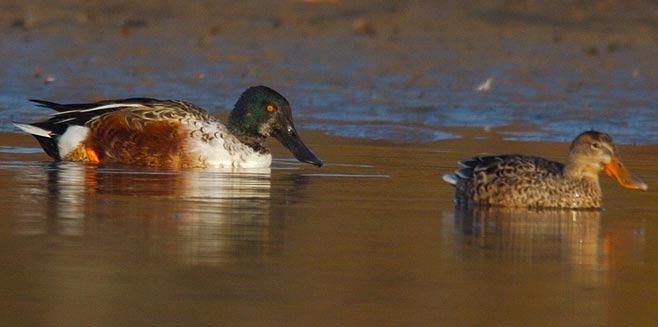|
Anas clypeata (Northern shoveler,
Northern shoveller)
Europese slopeend [Afrikaans]; Slobeend [Dutch]; Canard
souchet [French]; Löffelente [German]; Pato-trombeteiro-europeu [Portuguese]
Life
> Eukaryotes >
Opisthokonta
> Metazoa (animals) >
Bilateria >
Deuterostomia > Chordata >
Craniata > Vertebrata (vertebrates) > Gnathostomata (jawed
vertebrates) > Teleostomi (teleost fish) > Osteichthyes (bony fish) > Class:
Sarcopterygii (lobe-finned
fish) > Stegocephalia (terrestrial
vertebrates) > Tetrapoda
(four-legged vertebrates) > Reptiliomorpha > Amniota >
Reptilia (reptiles) >
Romeriida > Diapsida > Archosauromorpha > Archosauria >
Dinosauria
(dinosaurs) > Saurischia > Theropoda (bipedal predatory dinosaurs) >
Coelurosauria > Maniraptora > Aves
(birds) > Order: Anseriformes
> Family: Anatidae
 |
|
Northern shoveler male (left) and female (right),
Eagle Creek Park, Indiana, USA. [photo
Ryan Sanderson
©] |
Distribution and habitat
Breeds in North America and northern Eurasia, heading south
in the non-breeding season to West Africa and the area from Egypt to eastern
Zambia. It is a rare vagrant to southern Africa with most records in the Western
Cape and Gauteng, with about half a dozen more elsewhere in South Africa,
northern Namibia, northern Zimbabwe and southern Mozambique. It generally
favours shallow freshwater wetlands in grassland, with plenty of mud and
invertebrates.
Food
Mainly eats aquatic invertebrates, doing most of its
foraging by dabbling, diving or up-ending.
References
-
Hockey PAR, Dean WRJ and Ryan PG 2005. Roberts
- Birds of southern Africa, VIIth ed. The Trustees of the John Voelcker
Bird Book Fund, Cape Town.
|
